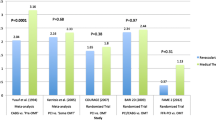Abstract
In patients with stable ischemic heart disease (SIHD), myocardial revascularization should be performed to either improve survival or improve symptoms and functional status among patients who are not well controlled with optimal medical therapy (OMT). A general consensus exists on the core elements of OMT, which include both lifestyle intervention and intensive secondary prevention with proven pharmacotherapies. By contrast, however, there is less general agreement as to what constitutes the optimal approach to revascularization in SIHD patients. The COURAGE and FAME 2 randomized trials form the foundation of the current clinical evidence base and raise the important question: “What is the impact of myocardial ischemia on myocardial revascularization in stable ischemic heart disease?”
Zusammenfassung
Bei Patienten mit stabiler ischämischer Herzkrankheit (SIHD) sollte eine myokardiale Revaskularisierung erfolgen, um entweder das Überleben oder die Symptome und den Funktionszustand bei Patienten zu verbessern, bei denen die Erkrankung trotz optimaler medikamentöser Therapie (OMT) nicht gut unter Kontrolle ist. Es besteht ein allgemeiner Konsens bei den Kernelementen der OMT, zu denen sowohl eine Änderung der Lebensweise als auch eine intensive Sekundärprävention mit bewährter Pharmakotherapie gehören. Dagegen besteht jedoch eine geringere Übereinstimmung hinsichtlich des optimalen Ansatzes für die Revaskularisierung bei SIHD-Patienten. Die randomisierten Studien COURAGE und FAME 2 bilden die Grundlage der aktuellen klinischen Evidenzbasierung und werfen die wichtige Frage auf: „Wie beeinflusst die Myokardischämie eine myokardiale Revaskularisierung bei stabiler ischämischer Herzkrankheit?“
Similar content being viewed by others
References
Fihn SD, Gardin JM, Abrams J et al (2012) ACCF/AHA/ACP/AATS/PCNA/SCAI/STS Guideline for the diagnosis and management of patients with stable ischemic heart disease: a report of the American College of Cardiology Foundation/American Heart Association Task Force on Practice Guidelines, and the American College of Physicians, American Association for Thoracic Surgery, Preventive Cardiovascular Nurses Association, Society for Cardiovascular Angiography and Interventions, and Society of Thoracic Surgeons. J Am Coll Cardiol 60(24):e44–e164
Lin GA, Dudley RA, Lucas FL et al (2008) Frequency of stress testing to document ischemia prior to elective percutaneous coronary intervention. JAMA 300(15):1765–1773
Boden WE, O’Rourke RA, Teo KK et al (2007) Optimal medical therapy with or without PCI in stable coronary disease. N Engl J Med 35:1503–1516
De Bruyne B, Pijls NHJ, Kalesan B et al (2012) Fractional flow reserve-guided PCI versus medical therapy in stable coronary artery disease. N Engl J Med 367:991–1001
Boden WE (2012) Which is more enduring–FAME or COURAGE? N Engl J Med 367(11):1059–1061
Hannan EL, Samadashvili Z, Cozzens K et al (2012) Comparative outcomes for patients who do and do not undergo percutaneous coronary intervention for stable coronary artery disease in New York. Circulation 125:1870–1879
Sidhu MS, Boden WE (2013) Does Revascularization Work? Heart Metab 58:10–14
Shaw LJ, Weintraub WS, Maron DJ et al (2012) Baseline stress myocardial perfusion imaging results and outcomes in patients with stable ischemic heart disease randomized to optimal medical therapy with or without percutaneous coronary intervention. Am Heart J 164(2):243–250
Shaw LJ, Cerqueira MD, Brooks MM et al (2012) Impact of left ventricular function and the extent of ischemia and scar by stress myocardial perfusion imaging on prognosis and therapeutic risk reduction in diabetic patients with coronary artery disease: results from the Bypass Angioplasty Revascularization Investigation 2 Diabetes (BARI 2D) trial. J Nucl Cardiol 19(4):658–669
The BARI-2D Study Group (2009) BARI 2D: a randomized clinical trial of treatment strategies for type 2 diabetes and coronary artery disease. N Engl J Med 360:2503–2515
Pursnani S, Korley F, Gopaul R et al (2012) Percutaneous coronary intervention versus optimal medical therapy in stable coronary artery disease: a systematic review and meta-analysis of randomized clinical trials. Circ Cardiovasc Interv 5(4):476–490
Hachamovitch R, Kang X, Amanullah AM et al (2009) Prognostic implications of myocardial perfusion single-photon emission computed tomography in the elderly. Circulation 120(22):2197–2206
Hachamovitch R, Rozanski A, Hayes SW et al (2006) Predicting therapeutic benefit from myocardial revascularization procedures: are measurements of both resting left ventricular ejection fraction and stress-induced myocardial ischemia necessary? J Nucl Cardiol 13(6):768–778
Hachamovitch R, Hayes SW, Friedman JD et al (2003) Comparison of the short-term survival benefit associated with revascularization compared with medical therapy in patients with no prior coronary artery disease undergoing stress myocardial perfusion single photon emission computed tomography. Circulation 107(23):2900–2907
Vlaszquez EJ, Lee KL, Deja MA et al (2011) Coronary-artery bypass surgery in patients with left ventricular dysfunction. (STICH trial) N Engl J Med 364:1607–1616
Serruys PW, Morice MC et al (2009) Percutaneous coronary intervention versus coronary-artery bypass grafting for severe coronary artery disease. SYNTAX trial. N Engl J Med 360:961–972
Farkouh ME, Domasnki M et al (2012) Strategies for multivessel revascularization in patients with diabetes. FREEDOM trial. N Engl J Med 367:2375–2384
Boden WE (2012) Weighing the evidence for decision making about percutaneous coronary intervention in patients with stable coronary artery disease. Circulation 125(15):1827–1831
Stergiopoulos K, Brown DL (2012) Initial coronary stent implantation with medical therapy versus medical therapy alone for stable coronary artery disease: meta-analysis of randomized controlled trials. Arch Intern Med 172:312–319
Boden WE (2012) Mounting evidence for the lack of PCI benefit in stable ischemic heart disease: what more will it take to turn the tide of treatment? Comment on “initial coronary stent implantation with medical therapy vs. medical therapy alone for stable coronary artery disease”. Arch Intern Med 172:319
Conflict of interest
On behalf of all authors, the corresponding author states the following: Dr. Boden is a Co-principal investigator of the ISCHEMIA trial, Drs. Torosoff and Sidhu are site Sub-PIs for the ISCHEMIA trial, Dr. Sidhu assists Dr. Boden in coordinating North Region sites for the ISCHEMIA trial [ClinicalTrials.gov Identifier:NCT01471522].
Author information
Authors and Affiliations
Corresponding author
Rights and permissions
About this article
Cite this article
Torosoff, M., Sidhu, M. & Boden, W. Impact of myocardial ischemia on myocardial revascularization in stable ischemic heart disease. Herz 38, 382–386 (2013). https://doi.org/10.1007/s00059-013-3824-0
Published:
Issue Date:
DOI: https://doi.org/10.1007/s00059-013-3824-0
Keywords
- Myocardial ischemia
- Myocardial revascularization
- Optimal medical therapy (OMT)
- Stable ischemic heart disease (SIHD)
- Coronary artery disease (CAD)




